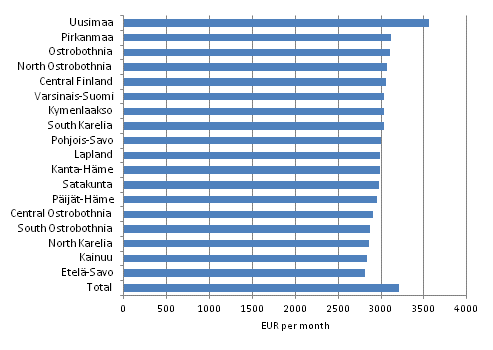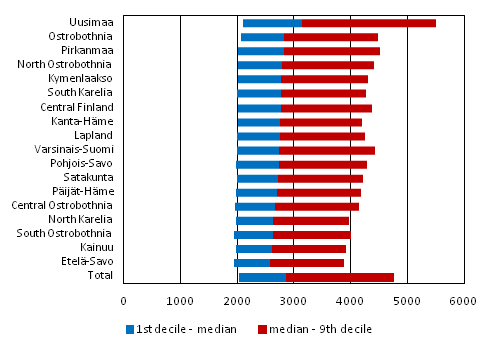Published: 8 April 2014
Wage and salary earners' average earnings considerably higher in Uusimaa than in other regions
According to Statistics Finland’s Structure of Earnings statistics, the average monthly earnings of full-time wage and salary earners in the last quarter of 2012 were EUR 3,206 and the median earnings were EUR 2,853. Of the regions, average earnings were highest in Uusimaa, EUR 3,560. The regions with the lowest earnings were Etelä-Savo (EUR 2,815) and Kainuu (EUR 2,832). Besides earnings for regular working hours, the earnings also include all bonuses and benefits in kind but not one-off pay items, such as performance-based bonuses.
Average for total earnings of full-time wage and salary earners in 2012

Average earnings in Uusimaa are boosted by the clearly higher earnings level in the highest earned income decile than in the rest of the country. The highest earning decile earned in Uusimaa EUR 5,505 or more. Correspondingly, the highest earning decile in Pirkanmaa earned at least EUR 4,520 and in Etelä-Savo EUR 3,872 in 2012.
The differences between regions are considerably smaller between the lowest earning decile (1st decile). In Uusimaa, a full-time wage or salary earner belonged to the first decile if he or she earned EUR 2,104 or less. In Pirkanmaa, the corresponding figure was EUR 2,008 and in Etelä-Savo EUR 1,942.
As a result of the bigger dispersion of wages and salaries, pay differentials are larger in Uusimaa than in other regions. The highest earning decile in Uusimaa earned 2.6 times or more than that earned by the lowest earning decile. The corresponding pay differential varied in other regions from 2.3 (Pirkanmaa) to 2.0 (Etelä-Savo). Detailed region-specific earnings data and dispersions can be found in Appendix table 1.
1st decile and 9th decile of full-time wage and salary earners by region in 2012, euros per month

The differences between regions in average earnings and dispersion of earnings are partly caused by differences in the structures of wage and salary earners. For example, more managers, professionals and associate professionals are working in Uusimaa than in the rest of the country. In these occupational groups, the earnings level is, on average, higher than in other occupational groups.
The data in the release derive from Statistics Finland's Structure of Earnings statistics. Monthly earnings for total hours worked are only calculated for full-time wage and salary earners. The earnings data released in the statistics are total earnings. Apart from earnings for regular working hours, total earnings also include pay for any possible overtime and working hour supplements, premium pays, supplements for location and adverse working conditions, supplements based on duties, professional skill and years of service, performance-based pay components, compensation for standby and on-call work and benefits in kind, but not one-off pay items, such as performance-based bonuses.
Source: Structure of Earnings 2012, Statistics Finland
Inquiries: Sampo Pehkonen 09 1734 3452, Jukka Pitkäjärvi 09 1734 3356, palkkarakenne@stat.fi
Director in charge: Hannele Orjala
Publication in pdf-format (253.5 kB)
- Reviews
- Tables
-
Tables in databases
Pick the data you need into tables, view the data as graphs, or download the data for your use.
Appendix tables
Updated 8.4.2014
Official Statistics of Finland (OSF):
Structure of Earnings [e-publication].
ISSN=1799-0092. 2012. Helsinki: Statistics Finland [referred: 27.12.2025].
Access method: http://stat.fi/til/pra/2012/pra_2012_2014-04-08_tie_001_en.html

